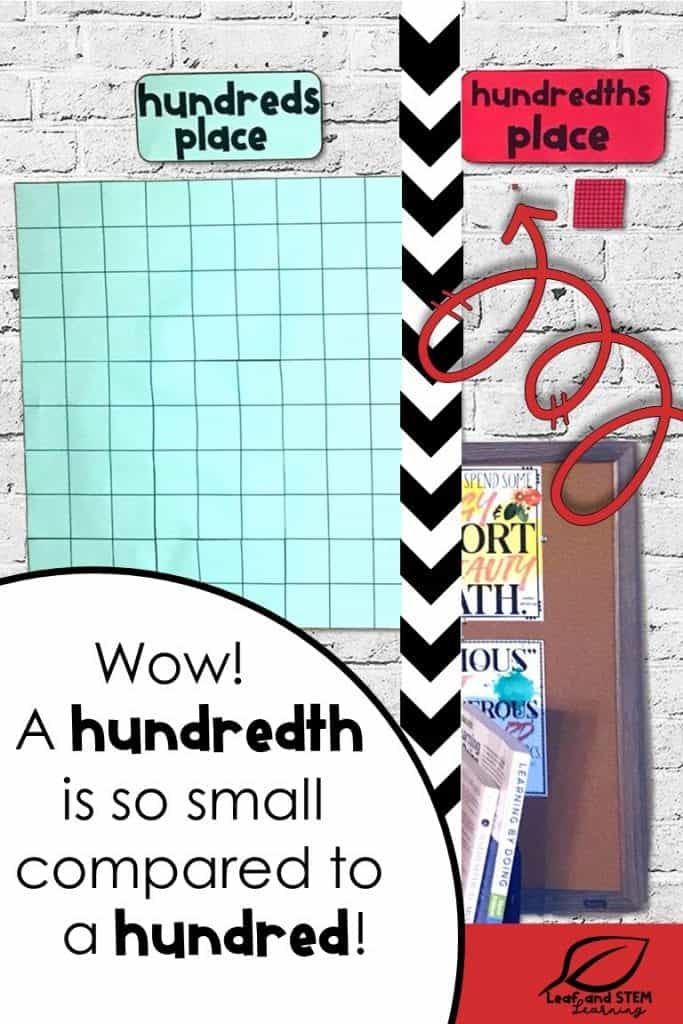Place value is often one of the first topics taught in 4th grade or 5th grade math, but it is not easy for many students. Getting students to REALLY understand how the place value system works is so important. Place value understanding builds into every operational task students will learn for the rest of the school year and beyond! Learn how to set up a lesson plan and anchor chart that students can touch, manipulate, and see all year to understand the place value system.

Students have trouble seeing how the location of the digit changes its value. There is a huge difference between the value of a 2 in the hundreds place and a 2 in the hundredths place. This place value anchor chart will help your students understand this tricky to visualize concept.
Gather the Materials
The materials you need to build your place value anchor chart are so easy and inexpensive. You will colored paper and either tape or glue. Grab five different colors of paper. Your favorite Astrobrights will be perfect for this project!
Plan the Timing
Think about whether you want to make the anchor chart ahead of time or with your students. There are benefits to both plans. If you make it ahead of time, you can save some lesson time in class. Making the anchor chart with your class may help students better understand each part of the chart and give them more buy-in as they helped create it.
Grab the printable kit at the bottom of this post!
Whole Number Place Value Anchor Chart
The first step is to create the whole number place value anchor chart pieces. In this model each square is one-whole. That means that one square represents a unit!
That means to represent the ones place, we need to use just one square. What will we use to show the tens place? Ten squares of course! Use the pieces in the printable kit to create a 1×10 array. This looks like a BIG version of the rod from your base 10 block kit!

Now you will create the 10 x 10 array. Wow! This looks like a lot of squares! Help your students notice how much bigger this part is compared to the tens place and the ones place. This 10 x 10 array looks like the flat from your base 10 block kit. You may want to make extra hundreds and tens models so that you can use them like HUGE base ten blocks. You can print some extra copies of the pages from the printable kit. If you are going to use these a lot or if you want to be able to write on them, you may want to laminate these after your lesson.
Decimal Place Value Anchor Chart
Next you will create the decimal portion of your anchor chart. Begin by referencing the unit square. How can we show something that is even smaller than one?
As a teacher, you of course know that the whole can be cut into fractional pieces. This is a great question to pose to your students. Each time we used 10 pieces to make a larger place value. Now we will cut the square into ten pieces to make the tenths place value.
There are two different versions of the tenths model. The first still shows a whole that has been split into ten pieces. This one is helpful for showing why a decimal number is the same as a fraction with a denominator of 10. The second one just shows one of these pieces.
The tenths pieces will look like miniature versions of the rods that are used for the tens place. This is no accident! The place value system is symmetrical around the ones place.
You will create the hundredths place model in the same way. Model that the hundredths place is created by dividing the tenths piece into ten more pieces. Now there are 100 tiny pieces. The hundredths place looks like a tiny version of the hundreds place value. Compare the hundredths piece with the hundreds piece. See if the students can come up with a strategy to figure out how many of those tiny hundredths pieces it takes to fill up the hundreds model.

Using the Place Value Anchor Chart for Instruction
Making the anchor chart is just the beginning. Are you ready to start using your anchor chart to guide some great classroom lessons? Use the lesson ideas below to jump start your school year!
Multiply by 10 and Divide by 10
This can be one of the most difficult parts of the place value system for students to understand. Use your anchor chart as a built-to-scale representation of hundreds to hundredths place. The pieces are visually 10x larger and smaller than the pieces to the left or right when lined up in order. Attach all of the pieces to your chalkboard or whiteboard and label each of the values.
Expanded Form and Expanded Notation
If you have laminated your place value anchor chart pieces, you will be able to write on them with dry erase markers. For example, write the numeral 5 on each of the squares on the tens rod. What is the value 5 x 10? It’s fifty! This shows how a number is multiplied by its place to find its value. Write the same 5 inside one of the tenths pieces and that is 5 x 1/10!
If you want to learn more about expanded form and expanded notation, check out this post!
Addition and Subtraction Manipulatives
Do you ever have students who try to line up a decimal under the whole numbers when they add or subtract? I know my fifth graders do this all the time! When you are adding and subtracting using regular base 10 blocks, you have to choose the scale. You can have the flat be a hundred to work with whole numbers. You can change the flat to be one whole to work with decimal numbers. With your place value anchor chart, you can show how numbers relate to each other from the hundreds to the hundredths place all at one time without switching scales! Now you can show how to subtract $15 and $8.75 using manipulatives.
Are you ready for more place value?
Don’t forget to sign up below to receive the printables to create your anchor chart sent to your inbox!
Place Value Anchor Chart Printables
Join Leaf and STEM Learning to get the place value printables and other updates, resources, and great learning materials sent straight to your inbox. I will never share your email address or spam you. Promise!
You have successfully subscribed. Check your inbox for your place value printable!
You may also be interested in some more place value resources for your 4th and 5th graders. Here is a quick list of some of my favorites!




